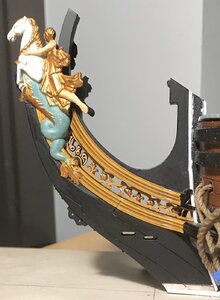-

Win a Free Custom Engraved Brass Coin!!!
As a way to introduce our brass coins to the community, we will raffle off a free coin during the month of August. Follow link ABOVE for instructions for entering.
-

PRE-ORDER SHIPS IN SCALE TODAY!
The beloved Ships in Scale Magazine is back and charting a new course for 2026!
Discover new skills, new techniques, and new inspirations in every issue.
NOTE THAT OUR FIRST ISSUE WILL BE JAN/FEB 2026
You are using an out of date browser. It may not display this or other websites correctly.
You should upgrade or use an alternative browser.
You should upgrade or use an alternative browser.
Soleil Royal by Heller - an Extensive Modification and Partial Scratch-Build by Hubac’s Historian
- Thread starter Hubac’s Historian
- Start date
- Watchers 81
-
- Tags
- 1689 heller hubac refit soleil royal
Much appreciated, Stephen and Mr. Shanks! It was a wonderful day.
Happy Birthday, Mark!! Much more happy and healthy years!! 

Of all the carved work that I have done for this project so far, the trailboard has been the most vexing, by a long-shot.
While I usually double-stick the work to a scrap of masonite, I reasoned that I would need to work this carving, constantly, from one side to the other. The necessity of this approach, as I quickly discovered, is underscored by the fact that - despite a sound indexing point, in the half-round forward notch - the paper patterns were just askew of each other, from one side to the other.
I wonder whether this can be attributed to the paper expanding unevenly, upon application of the water-based glue stick. I don’t use solvent-based spray adhesives because of the plastic.
Whatever the case may be, working both sides enables you to meet at the middle and smooth a transition between the two sides. It’s all just extremely time consuming, but then, I’m a glutton...
While it seemed like a good idea to work from the outside, in - my mistake was in relieving the Xs, first. I should have saved this for last because doing so made the work especially fragile. The design calls for shell reliefs inside these X’s, but I just did not think I could pull that off in this scale. Instead, I opted for the lightness and visual interest that opening up the negative space provides. These pictures don’t reflect the current, near finished state of the carving, but they do provide a sense of scale:
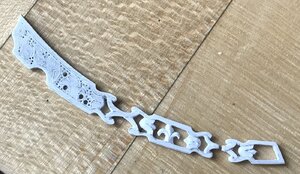
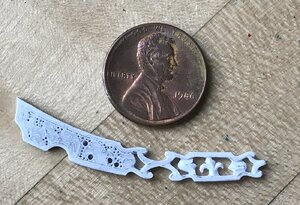
Presently, I’m carving the year marker, and will soon clear up any fuzzy bits, re-join the broken bit and paint before installation. I am happy with the way that it came out, but it was a real devil of a job to get there.
The other project that has consumed an in-ordinate amount of time was fairing back the knee extensions of the head.
This has been a process of adding back plastic and slowly fairing to the new contour of the bow, until I had a solid joint at the cut-off point, all along the top edge of the knee extension and connection at the side.
What makes all of this difficult, of course, is that the bow extensions that I installed, earlier, flatten the bow a bit, near the stem. But, then, I also filled the space between the lower two wales, as an extension of the anchor lining. And, for good measure, I padded-out the leading edge of the stem by a 1/16”; that is all a lot of new reality to fair to. As such, I decided not to worry about connection along the bottom edge, as long as I had a solid glue joint at the joint, top and sides:
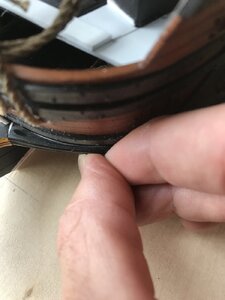
In these two pics, you can see how the first round of shims didn’t quite get me where I needed to be.
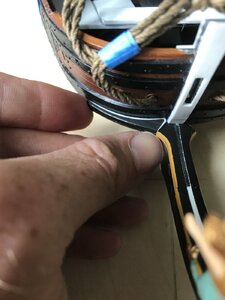
After more shimming, I finally got the port side secured:
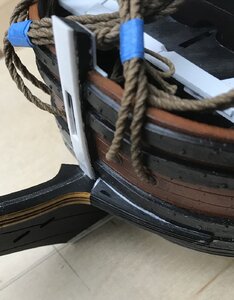
But, the starboard side was a real PITA; I’d shim, file away too much in the wrong spot, then re-shim, etc. Eventually, I got it right:
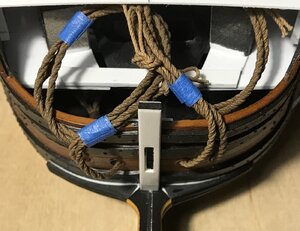
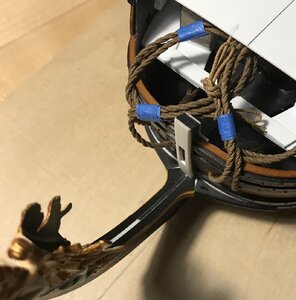
Though, I still have some putty work to do, before painting these extensions, you can see that they align neatly with the wales and present a fair transition:
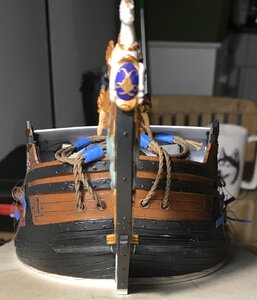
With that at an acceptable state, I set to work making a few slight modifications to the upper knee.
I filed more of a hook for the collar of the main stay, and added a half round moulding to the profile just above:
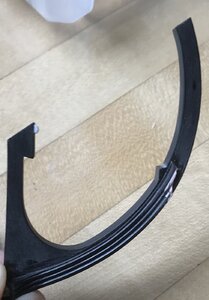
You can see the bit of BONDO patch to the forward end of the fluted moulding. That was because of this gap between the tail of the figurehead and the moulding:

All of the parts of the head are warped just enough that problems like this are un-avoidable, despite best efforts to fair and straighten things out as I glued the figurehead to the cutwater assembly. This gap does not exist on the port side. Leaving the gap, though, spoils the illusion that this is more than just a plastic model.
Re-shaping the patch didn’t take long, and it was time well spent:
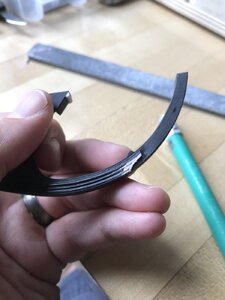
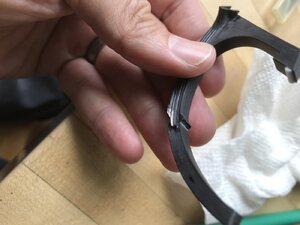
Unfortunately, I made a dog’s breakfast of my first attempt to paint the upper knee. The black went on gloppy, and I had to scrape the whole thing clean and re-do it. I’ve also painted in the yellow ocher and now this part is ready for installation, following the trailboard piece.
SOS BONUS SHOT
I’m home now, and cleaned up the trailboard so that I could glue it back together. I set it in place, temporarily until the glue dries:
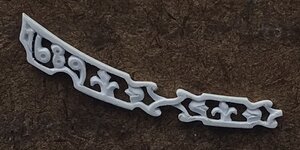
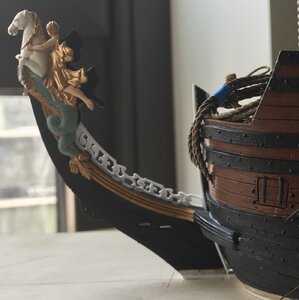
As a side note, I have found the Tamiya acrylics to be very difficult paints for brushing; they practically dry on the brush before you can apply them, and it takes multiple applications for the necessary depth of color. Does anyone know of any additives or conditioners that make them more user-friendly for brushing?
Next, I will tackle the short beakhead deck and the beakhead bulkhead. I have figured out ways to re-cycle the stock kit parts, which saves me from the sort of frame and plank job I did on the lower transom.
Many thanks for the birthday wishes, and as ever - thank you for your interest, your likes and your comments.
Be well!
While I usually double-stick the work to a scrap of masonite, I reasoned that I would need to work this carving, constantly, from one side to the other. The necessity of this approach, as I quickly discovered, is underscored by the fact that - despite a sound indexing point, in the half-round forward notch - the paper patterns were just askew of each other, from one side to the other.
I wonder whether this can be attributed to the paper expanding unevenly, upon application of the water-based glue stick. I don’t use solvent-based spray adhesives because of the plastic.
Whatever the case may be, working both sides enables you to meet at the middle and smooth a transition between the two sides. It’s all just extremely time consuming, but then, I’m a glutton...
While it seemed like a good idea to work from the outside, in - my mistake was in relieving the Xs, first. I should have saved this for last because doing so made the work especially fragile. The design calls for shell reliefs inside these X’s, but I just did not think I could pull that off in this scale. Instead, I opted for the lightness and visual interest that opening up the negative space provides. These pictures don’t reflect the current, near finished state of the carving, but they do provide a sense of scale:


Presently, I’m carving the year marker, and will soon clear up any fuzzy bits, re-join the broken bit and paint before installation. I am happy with the way that it came out, but it was a real devil of a job to get there.
The other project that has consumed an in-ordinate amount of time was fairing back the knee extensions of the head.
This has been a process of adding back plastic and slowly fairing to the new contour of the bow, until I had a solid joint at the cut-off point, all along the top edge of the knee extension and connection at the side.
What makes all of this difficult, of course, is that the bow extensions that I installed, earlier, flatten the bow a bit, near the stem. But, then, I also filled the space between the lower two wales, as an extension of the anchor lining. And, for good measure, I padded-out the leading edge of the stem by a 1/16”; that is all a lot of new reality to fair to. As such, I decided not to worry about connection along the bottom edge, as long as I had a solid glue joint at the joint, top and sides:

In these two pics, you can see how the first round of shims didn’t quite get me where I needed to be.

After more shimming, I finally got the port side secured:

But, the starboard side was a real PITA; I’d shim, file away too much in the wrong spot, then re-shim, etc. Eventually, I got it right:


Though, I still have some putty work to do, before painting these extensions, you can see that they align neatly with the wales and present a fair transition:

With that at an acceptable state, I set to work making a few slight modifications to the upper knee.
I filed more of a hook for the collar of the main stay, and added a half round moulding to the profile just above:

You can see the bit of BONDO patch to the forward end of the fluted moulding. That was because of this gap between the tail of the figurehead and the moulding:

All of the parts of the head are warped just enough that problems like this are un-avoidable, despite best efforts to fair and straighten things out as I glued the figurehead to the cutwater assembly. This gap does not exist on the port side. Leaving the gap, though, spoils the illusion that this is more than just a plastic model.
Re-shaping the patch didn’t take long, and it was time well spent:


Unfortunately, I made a dog’s breakfast of my first attempt to paint the upper knee. The black went on gloppy, and I had to scrape the whole thing clean and re-do it. I’ve also painted in the yellow ocher and now this part is ready for installation, following the trailboard piece.
SOS BONUS SHOT
I’m home now, and cleaned up the trailboard so that I could glue it back together. I set it in place, temporarily until the glue dries:


As a side note, I have found the Tamiya acrylics to be very difficult paints for brushing; they practically dry on the brush before you can apply them, and it takes multiple applications for the necessary depth of color. Does anyone know of any additives or conditioners that make them more user-friendly for brushing?
Next, I will tackle the short beakhead deck and the beakhead bulkhead. I have figured out ways to re-cycle the stock kit parts, which saves me from the sort of frame and plank job I did on the lower transom.
Many thanks for the birthday wishes, and as ever - thank you for your interest, your likes and your comments.
Be well!
Last edited:
Hi Hubac,
Your colors on the figure head look fantastic, along with your amazing trail board.
I agree Tamiya Acrylics don't brush all that well on large surfaces, in my experience Tamiya Acrylics are fine for small brush jobs. I have used Mr Color Leveling Thinner when spraying it acts a bit like a retarder giving the paint a bit of time to settle before setting, it may improve the brush ability a bit. Otherwise Citadel paints are suppose to be good for brushing while still being an Acrylic. Other than that Enamel is great for brushing only problem you will have to wait a couple of weeks if you want to put Acrylic over the top, hope this helps though I am probably not telling you too much new stuff.
Cheers,
Stephen.
Your colors on the figure head look fantastic, along with your amazing trail board.
I agree Tamiya Acrylics don't brush all that well on large surfaces, in my experience Tamiya Acrylics are fine for small brush jobs. I have used Mr Color Leveling Thinner when spraying it acts a bit like a retarder giving the paint a bit of time to settle before setting, it may improve the brush ability a bit. Otherwise Citadel paints are suppose to be good for brushing while still being an Acrylic. Other than that Enamel is great for brushing only problem you will have to wait a couple of weeks if you want to put Acrylic over the top, hope this helps though I am probably not telling you too much new stuff.
Cheers,
Stephen.
Incredible detail - I love what you are doing - just beautiful workmanship.
Thank you, Stephen and Donnie! I really appreciate that you are both enjoying this project, and it will only get better from here, as I move into the more heavily ornamental aspects of the build.
Stephen, I will look into this Mr. Color product. That sounds exactly like what I am looking for. When you have sprayed with it, are their hard and fast ratios that you mix to, or is it the kind of thing that you can sort of wing-it, a bit?
I will also say that I love the Citadel line, as well. My gold metallic is Citadel and it lays down beautifully. Originally, I had selected an artist’s acrylic gold that had exactly the richness that I was looking for, but it was murder to apply. Then, I discovered that the Citadel gold gave me exactly the same gold hue. I use their bronze metallic for the guns. Their washes are also excellent. I’ll be heading to the WarHammer shop, downtown, soon because I need a good silver metallic. Those guys at the shop are extremely helpful!
Stephen, I will look into this Mr. Color product. That sounds exactly like what I am looking for. When you have sprayed with it, are their hard and fast ratios that you mix to, or is it the kind of thing that you can sort of wing-it, a bit?
I will also say that I love the Citadel line, as well. My gold metallic is Citadel and it lays down beautifully. Originally, I had selected an artist’s acrylic gold that had exactly the richness that I was looking for, but it was murder to apply. Then, I discovered that the Citadel gold gave me exactly the same gold hue. I use their bronze metallic for the guns. Their washes are also excellent. I’ll be heading to the WarHammer shop, downtown, soon because I need a good silver metallic. Those guys at the shop are extremely helpful!
Last edited:
Excellent work Marc.I can only imagine how fine the tailboard carving is, knowing how small the details are on mine in 1/36!
I mix Tamiya Acrylic with their X20A thinner when brushing, completely different animal then It includes a retarder, my understanding is it was never designed to use straight from the pot.
It includes a retarder, my understanding is it was never designed to use straight from the pot.
Steve I have Mr Hobby's self levelling thinner, but is this not just for laquer based Acrylics,i.e. Mr Color?
Kind Regards
Nigel
I mix Tamiya Acrylic with their X20A thinner when brushing, completely different animal then
Steve I have Mr Hobby's self levelling thinner, but is this not just for laquer based Acrylics,i.e. Mr Color?
Kind Regards
Nigel
 , now we are getting closer on the trail. Can you recommend any particular thinning ratio, Nigel?
, now we are getting closer on the trail. Can you recommend any particular thinning ratio, Nigel?Also, while browsing around for the port bow view of La Reyne, this morning, I found this much less circulated VDV of her starboard quarter, which gives her a somewhat different aspect, from the other starboard quarter drawing:
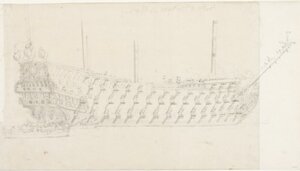
As compared to this:
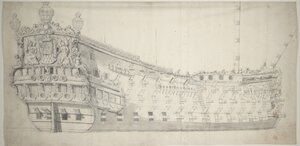
As the nearest Hubac-built contemporary of SR, La Reyne is fundamental to my eventual “forensic reconstruction” of SR, 1670.
It is hard not to be impressed by the sheer size and mass of the French ships.
Excellent work Marc.I can only imagine how fine the tailboard carving is, knowing how small the details are on mine in 1/36!
I mix Tamiya Acrylic with their X20A thinner when brushing, completely different animal thenIt includes a retarder, my understanding is it was never designed to use straight from the pot.
Steve I have Mr Hobby's self levelling thinner, but is this not just for laquer based Acrylics,i.e. Mr Color?
Kind Regards
Nigel
Hi Nigel,
Oops my mistake, you are right it is for Laquer based paints the good news is Tamiya Acrylic can be mixed with this sort of Laquer thinner without any problem. Maybe Marc should try the X20A first as you suggested.
Cheers,
Stephen.
Marc
For brush work you need around 3 parts paint to 1 part thinner, for Airbrush 1 part paint to 3 parts thinner.I have found that Tamiya Acrylic as with most paints prefers a couple of thin coats as opposed to one thick one.You will find that even black will need a couple of coats but does laydown like silk provided you don't over brush.
I could NEVER get decent results with Tamiya Acrylics until I discovered the secret of using their thinners, the difference really is night and day.They are more than just water, they incorporate a retarder and a flow enhancer to break down surface tension.
Kind Regards
Nigel
For brush work you need around 3 parts paint to 1 part thinner, for Airbrush 1 part paint to 3 parts thinner.I have found that Tamiya Acrylic as with most paints prefers a couple of thin coats as opposed to one thick one.You will find that even black will need a couple of coats but does laydown like silk provided you don't over brush.
I could NEVER get decent results with Tamiya Acrylics until I discovered the secret of using their thinners, the difference really is night and day.They are more than just water, they incorporate a retarder and a flow enhancer to break down surface tension.
Kind Regards
Nigel
Thank you for that, Nigel! I will pick up some of that thinner. I’m sure I could mix colors for a friendlier brand, but the color I’ve arrived at really is perfect. This will enable me to use it without losing my mind.
Awesome work Marc!I love the 1689 incorporated in the design
Kind Regards
Nigel
Kind Regards
Nigel
One of the primary benefits of the long time that it has taken me to get to this point is that I have had plenty of time to figure out how best to tackle the more vexing aspects of the ornamental program.
The amortisement of the quarter galleries is tricky because it must all remain very shallow, while giving the impression of a full relief.
The specific aspect of the amortisement that I am working on now are these pairs of dolphins, flanking the two windows, on the main deck level:
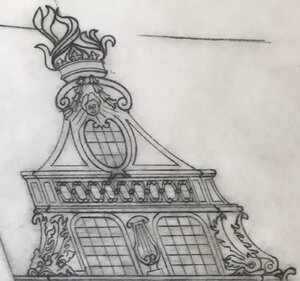
My interpretation of this carving is that the inner dolphins should project, outboard, just a bit further than theouter dolphins. First, I considered attempting to cut the relief into one solid piece of 1/16” styrene. I thought, however, that it would be extremely challenging to level clean grounds, around the bas relief, at this scale.
Then it dawned on me to build the relief up as a series of layers: a background layer, or base of thin stock; the outer dolphind and inner border from the same thin stock; finally - the inner dolphins from slightly thicker stock.
The other consideration I was weighing is that I wanted to find a way to reduce the verticality of the amortisement just enough so that I didn’t have to alter my forward pixie, in order to keep my aft octagonal port.
This main deck level of the amortisement proved to be the ideal location for this height reduction. First of all, as Berain originally drew them, these two false windows are out of proportion with their counterparts on the stern; a height reduction, here, would help to harmonize the quarters with the stern.
Cutting the window height down is no big deal, and I had to re-draw the harp, anyway. However, the dolphin carvings needed to shrink proportionally.
By increments of 5%, I reduced my quarter drawings until I arrived at 90% of the original. This resulted in a full 1/16” reduction, in height, of the dolphin carvings, and a hair less in their width. Ultimately, this reduction may not fully clear the pixie from the octagonal port, but the interference between the two should he greatly reduced. It will be impossible to gauge that until I’m actually assembling the amortisement.
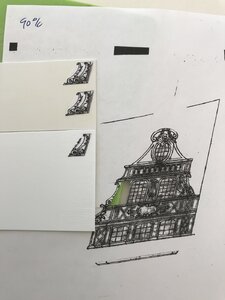

Ultimately, the dolphin carving blanks consumed most of the additional width allowance I had incorporated into the base layer. This won’t affect the overall width of the amortisement, on this main deck level, as you can see below:
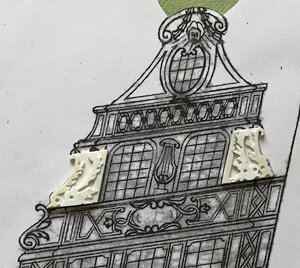
I could even leave these as they are, and they would he passable, however, with just a little modeling they will really pop. Back when I was drawing all of this, I thought these dolphins were just going to be murder to make. As it turns out, they should actually be one of the more straight-forward bits of carved work on the ship.
Here are a few shots of my extended beakhead deck:
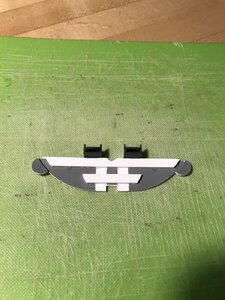
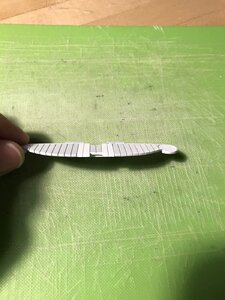
As I have throughout the model, I engraved plank seams along the edges.
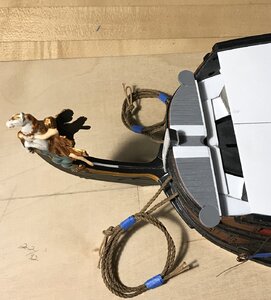
It was necessary to fill and fair the glue-edge beneath this beakhead deck with a strip of styrene, but that will all be seamless, now, once the deck gets glued down.
I’ll actually have a little time in the shop, today, so I plan to rough out my blanks for the lower portion of the QGs, on the bandsaw.
More to follow - thanks for looking in!
The amortisement of the quarter galleries is tricky because it must all remain very shallow, while giving the impression of a full relief.
The specific aspect of the amortisement that I am working on now are these pairs of dolphins, flanking the two windows, on the main deck level:

My interpretation of this carving is that the inner dolphins should project, outboard, just a bit further than theouter dolphins. First, I considered attempting to cut the relief into one solid piece of 1/16” styrene. I thought, however, that it would be extremely challenging to level clean grounds, around the bas relief, at this scale.
Then it dawned on me to build the relief up as a series of layers: a background layer, or base of thin stock; the outer dolphind and inner border from the same thin stock; finally - the inner dolphins from slightly thicker stock.
The other consideration I was weighing is that I wanted to find a way to reduce the verticality of the amortisement just enough so that I didn’t have to alter my forward pixie, in order to keep my aft octagonal port.
This main deck level of the amortisement proved to be the ideal location for this height reduction. First of all, as Berain originally drew them, these two false windows are out of proportion with their counterparts on the stern; a height reduction, here, would help to harmonize the quarters with the stern.
Cutting the window height down is no big deal, and I had to re-draw the harp, anyway. However, the dolphin carvings needed to shrink proportionally.
By increments of 5%, I reduced my quarter drawings until I arrived at 90% of the original. This resulted in a full 1/16” reduction, in height, of the dolphin carvings, and a hair less in their width. Ultimately, this reduction may not fully clear the pixie from the octagonal port, but the interference between the two should he greatly reduced. It will be impossible to gauge that until I’m actually assembling the amortisement.


Ultimately, the dolphin carving blanks consumed most of the additional width allowance I had incorporated into the base layer. This won’t affect the overall width of the amortisement, on this main deck level, as you can see below:

I could even leave these as they are, and they would he passable, however, with just a little modeling they will really pop. Back when I was drawing all of this, I thought these dolphins were just going to be murder to make. As it turns out, they should actually be one of the more straight-forward bits of carved work on the ship.
Here are a few shots of my extended beakhead deck:


As I have throughout the model, I engraved plank seams along the edges.

It was necessary to fill and fair the glue-edge beneath this beakhead deck with a strip of styrene, but that will all be seamless, now, once the deck gets glued down.
I’ll actually have a little time in the shop, today, so I plan to rough out my blanks for the lower portion of the QGs, on the bandsaw.
More to follow - thanks for looking in!
These are difficult to photograph, but I am very happy with the modeling and the overall impression of these:
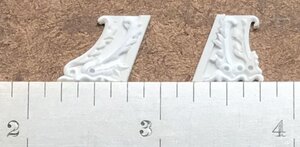
Now that I have worked through the problems, the starboard pair should come out even better.
To finish these off, I’ll insert domed bits of styrene rod into the eye sockets.
I really appreciate all of the likes and kind comments!

Now that I have worked through the problems, the starboard pair should come out even better.
To finish these off, I’ll insert domed bits of styrene rod into the eye sockets.
I really appreciate all of the likes and kind comments!
I am sure carve those is more difficult than photograph 
Here’s a small, but I think interesting realization I had over the weekend.
Berain’s new ornamental scheme for L’Agreable also incorporates small winged fairies:
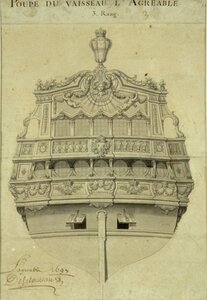
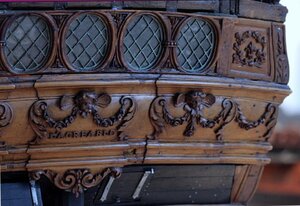
This is interesting to me because even at this later date, winged fairies are still part of Berain’s design vocabulary.
Skeptics of the authenticity of the mermaid pixies, on the amortisement, tend to view them as something that may have been present much earlier than 1689 - perhaps as part of the original ornamental scheme.
I tend to think that their presence, here on L’Agreable, at the hand of Berain, re-enforces 1689 as the more likely contextual time frame for my quarter gallery design. These figures are cherubs, and not specifically female, but note the presence of swaged garlands, below. This is all consistent with the ornamental language of Soleil Royal.
Berain’s new ornamental scheme for L’Agreable also incorporates small winged fairies:


This is interesting to me because even at this later date, winged fairies are still part of Berain’s design vocabulary.
Skeptics of the authenticity of the mermaid pixies, on the amortisement, tend to view them as something that may have been present much earlier than 1689 - perhaps as part of the original ornamental scheme.
I tend to think that their presence, here on L’Agreable, at the hand of Berain, re-enforces 1689 as the more likely contextual time frame for my quarter gallery design. These figures are cherubs, and not specifically female, but note the presence of swaged garlands, below. This is all consistent with the ornamental language of Soleil Royal.
So, the knee extensions are glued-in, and I think the run of their sweep is fair and consistent. I like the look of the raised bolsters around the hawse holes.
Given how fragile the artists’ acrylic, raw sienna was when I applied it - I was surprised at how difficult it was to scrape away from the glue areas, a year later. Granted, there was a clear topcoat applied, but it took real effort to scrape the yellow, once you were past the topcoat.
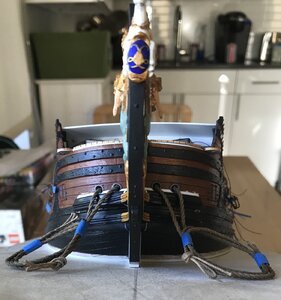
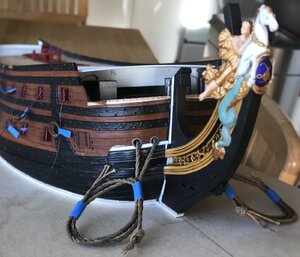
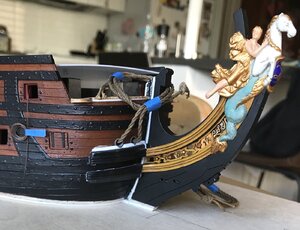
There’s a little bit of putty work that still needs to happen, here, and then I’ll prime, paint and repair finishes in the bow area.
The beakhead deck is secure, now. You can see the styrene fill, along the leading edge:
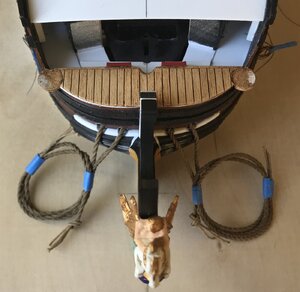
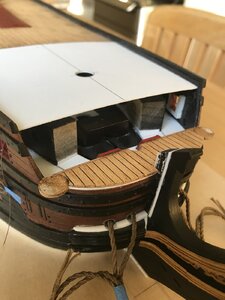
Filling that gap facilitated a natural camber which should be present, anyway.
Ultimately, I have decided that I will maintain the roundhouses. While I agree with Chapman that they probably are not correct, the wrapping hull modification was complicated by the fact that this sweeping wrap extends up into the upper bulwarks. Builders of this kit know that the upper bulwarks are separate pieces that I am nowhere near ready to install. So, I think I will just avoid all of that, on this build, and look to install additional simple seats of ease. Here are the roundhouses painted, but not installed:
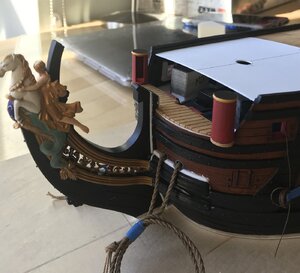
I have not yet applied the walnut ink wash. This red color, though, will be what I apply to the beakhead bulkhead, along the run of the main deck ports, selectively throughout the lower quarter galleries, and throughout the stern facade. It is also an artist acrylic, proprietary mix for BLICK.
I’ve thinned it considerably with water, and the color lays down beautifully in thin coats. I have found that the artists’ acrylics are hit or miss. Fortunately, my blues are going to work!
I also picked up a bottle of the Tamiya X20 thinner for acrylics, and this helped with the application of my yellow ocher, so that was a great help - thanks, again Nigel!
I’m finishing up my starboard amortisement dolphins, and I was amazed to realize that they are about 1/32” taller than the port side:
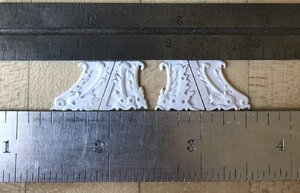
Here, I have the P&S forward carvings back to back:
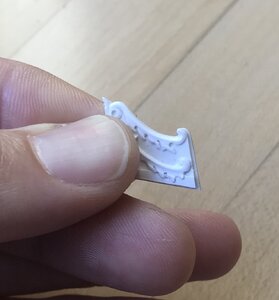
I double-checked the 90% reduction photo copies and there is no distortion from one side to the other. They match up perfectly. I can adjust this, so that both sides match, but it remains a mystery.
I have figured out what the process will be for making the false amortisement windows that go between these dolphin carvings. Those will be my next small-work project, and I think they should be relatively straight-forward.
Here is the stock port headrail, as it currently aligns:
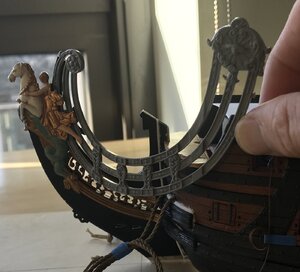
Unfortunately, I will not be able to use these; the headrails need to lap the hull by about another 1/4”, and there is no feasible way to stretch or modify these so that they look good and right.
Patterning new ones will enable me to correct the problem of the forward scroll rising up, alongside the sprit-mast, thus spoiling the line fairleads. I will also be able to space the headrail vertical timbers (decorated with lyres in Berain’s drawing) so that they align with the headrail supporting timbers. This way, I can space those supporting timbers, along the trailboard, in a way that makes sense. Ultimately, I believe that I can graft the forward scroll and rear escutcheon onto the new headrails, thus saving an enormous amount of time.
If I can achieve all of that, I will have done justice to the bow. Before I do my paint touch-ups, I’ll get busy extending the beakhead bulkhead and getting that in place.
Thank you all for looking in. Enjoy this last week of the summer, as best you can!
Given how fragile the artists’ acrylic, raw sienna was when I applied it - I was surprised at how difficult it was to scrape away from the glue areas, a year later. Granted, there was a clear topcoat applied, but it took real effort to scrape the yellow, once you were past the topcoat.



There’s a little bit of putty work that still needs to happen, here, and then I’ll prime, paint and repair finishes in the bow area.
The beakhead deck is secure, now. You can see the styrene fill, along the leading edge:


Filling that gap facilitated a natural camber which should be present, anyway.
Ultimately, I have decided that I will maintain the roundhouses. While I agree with Chapman that they probably are not correct, the wrapping hull modification was complicated by the fact that this sweeping wrap extends up into the upper bulwarks. Builders of this kit know that the upper bulwarks are separate pieces that I am nowhere near ready to install. So, I think I will just avoid all of that, on this build, and look to install additional simple seats of ease. Here are the roundhouses painted, but not installed:

I have not yet applied the walnut ink wash. This red color, though, will be what I apply to the beakhead bulkhead, along the run of the main deck ports, selectively throughout the lower quarter galleries, and throughout the stern facade. It is also an artist acrylic, proprietary mix for BLICK.
I’ve thinned it considerably with water, and the color lays down beautifully in thin coats. I have found that the artists’ acrylics are hit or miss. Fortunately, my blues are going to work!
I also picked up a bottle of the Tamiya X20 thinner for acrylics, and this helped with the application of my yellow ocher, so that was a great help - thanks, again Nigel!
I’m finishing up my starboard amortisement dolphins, and I was amazed to realize that they are about 1/32” taller than the port side:

Here, I have the P&S forward carvings back to back:

I double-checked the 90% reduction photo copies and there is no distortion from one side to the other. They match up perfectly. I can adjust this, so that both sides match, but it remains a mystery.
I have figured out what the process will be for making the false amortisement windows that go between these dolphin carvings. Those will be my next small-work project, and I think they should be relatively straight-forward.
Here is the stock port headrail, as it currently aligns:

Unfortunately, I will not be able to use these; the headrails need to lap the hull by about another 1/4”, and there is no feasible way to stretch or modify these so that they look good and right.
Patterning new ones will enable me to correct the problem of the forward scroll rising up, alongside the sprit-mast, thus spoiling the line fairleads. I will also be able to space the headrail vertical timbers (decorated with lyres in Berain’s drawing) so that they align with the headrail supporting timbers. This way, I can space those supporting timbers, along the trailboard, in a way that makes sense. Ultimately, I believe that I can graft the forward scroll and rear escutcheon onto the new headrails, thus saving an enormous amount of time.
If I can achieve all of that, I will have done justice to the bow. Before I do my paint touch-ups, I’ll get busy extending the beakhead bulkhead and getting that in place.
Thank you all for looking in. Enjoy this last week of the summer, as best you can!




